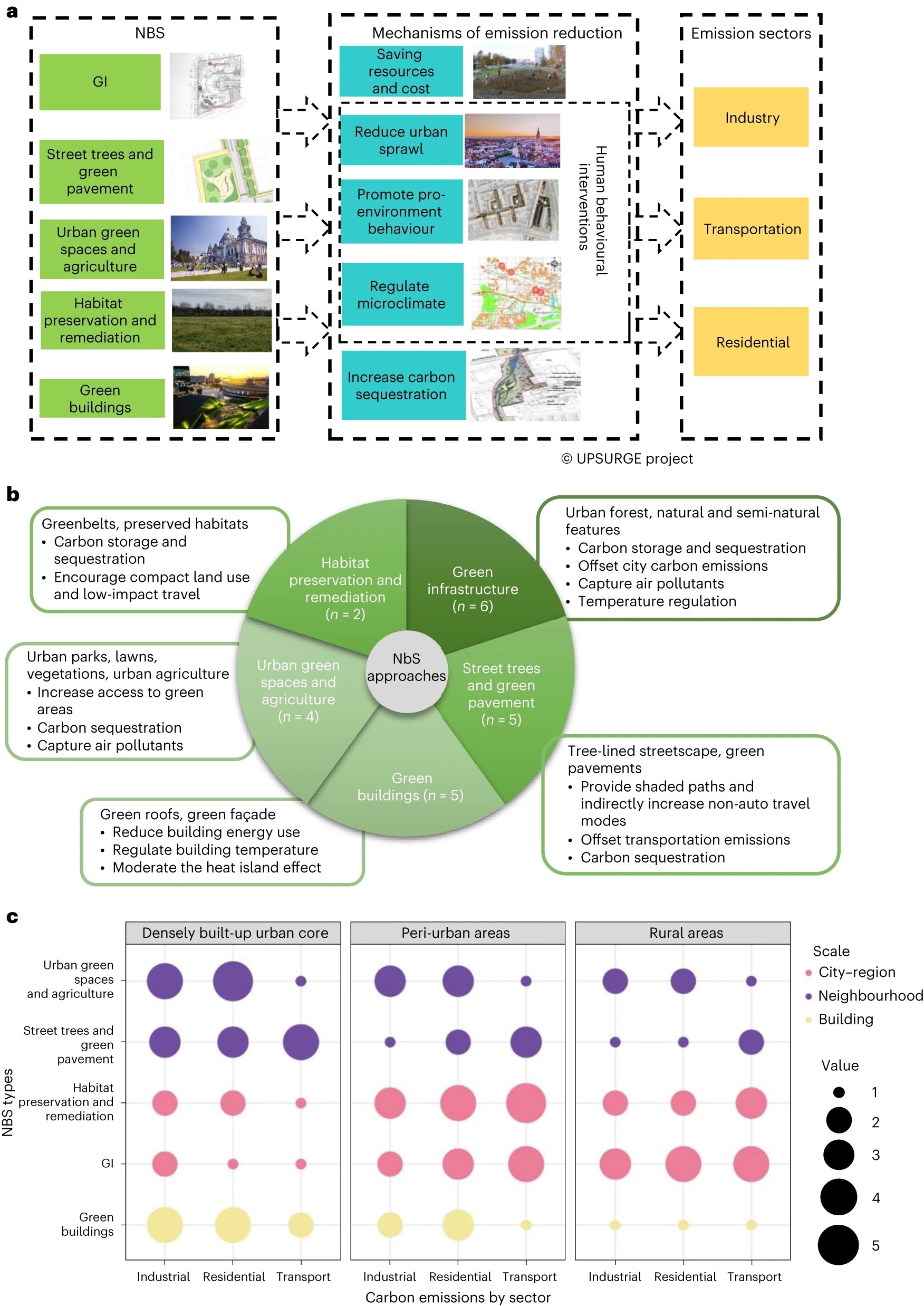Urban Green Solutions Drive Carbon Reduction
Zahra Kalantari
KTH Royal Institute of Technology, Sweden
Winning article: Contribution of prioritized urban nature-based solutions allocation to carbon neutrality (Nature Climate Change, 2023)
“As cities continue to grow and face escalating climate challenges, embracing Nature-Based Solutions offers a pathway to sustainable urban development that benefits both people and the planet.”
Nature-based solutions (NBS) have been widely researched and celebrated for their numerous benefits and co-benefits when applied in urban settings, including contributing to urban resilience and climate change mitigation. Yet, despite their growing popularity, the question of their true potential to reduce greenhouse gas (GHG) emissions on a city-wide scale has remained largely unanswered. Conventional wisdom suggests that green infrastructure can contribute to emissions reductions, but is this impact significant enough to play a meaningful role in achieving net-zero targets? This question becomes even more critical as cities, responsible for over 70% of global emissions, are increasingly tasked with leading climate action.
Previous studies have often concluded that the climate benefits of urban NBS are relatively modest, mainly because they focus predominantly on the direct mechanism by which NBS can offset GHG emissions, namely carbon sequestration. Large tracts of forests or other vegetation are needed in order to offer sufficient sequestration capacity to offset the levels of emissions seen in most cities currently, and urban NBS generally only feature relatively small areas of vegetation, with correspondingly limited carbon sequestration potential. However, this perspective overlooks the multiple mechanisms through which NBS can indirectly reduce emissions. For instance, urban trees and green roofs not only sequester carbon but also reduce energy demand by cooling buildings and influencing urban microclimates. Additionally, well-designed green spaces can promote behavioral changes, such as increased walking and cycling, further contributing to emissions reductions. With this in mind, our research set out to explore two fundamental questions: 1) Can NBS significantly reduce urban GHG emissions? 2) How can we spatially prioritize NBS to maximize their impact?
Our study quantifies the GHG mitigation potential of NBS by examining direct and indirect mechanisms, including resource savings, behavior changes, and microclimate regulation. By applying spatial prioritization, we found that maximizing NBS implementations could reduce urban carbon emissions by an average of 17.4% and up to 57.3% when combined with other mitigation strategies in EU cities by 2030. Notably, some cities with optimized NBS allocations could achieve near-zero net emissions, with a few cities reaching full carbon neutrality by 2030 in our modelling. These findings demonstrate that NBS are not merely complementary climate actions but can be central to urban carbon neutrality strategies.
The key to unlocking the full potential of NBS lies in strategic spatial planning. Unlike conventional approaches that apply NBS uniformly, our model identifies high-impact areas where NBS can yield the greatest emissions reductions and co-benefits. For example, urban forests strategically located in high-density neighborhoods can optimize cooling effects and energy savings, while green corridors connecting parks and public spaces can encourage sustainable mobility. By adopting our spatial prioritization model, cities can effectively allocate resources and target investments in green infrastructure, urban forests, and sustainable streetscapes, enhancing both climate resilience and urban livability.
Our research provides actionable insights for policymakers and urban planners striving to integrate NBS into climate action plans. Many cities already incorporate NBS into their policies but lack guidance on where and how to deploy them most effectively. Our results can inform urban policy frameworks that integrate nature-based solutions into climate action plans, offering practical tools for cities to achieve climate neutrality targets, enhance urban resilience, and contribute to planetary boundary goals. Policymakers can apply these insights to create incentives for green building practices and enforce land-use regulations that promote compact urban development and habitat preservation, reducing emissions across sectors. Moreover, our model can also be adapted commercially to guide both public planners and private developers in how and where they can use NBS to reduce and offset the GHG emissions associated with new development.
The implications of our findings extend beyond urban emissions reductions. By demonstrating the effectiveness of NBS in reducing urban carbon footprints, our research contributes to a broader understanding of how cities can operate within planetary boundaries. This aligns with global sustainability goals by ensuring urban growth occurs within ecological limits while promoting human well-being.
Current trends in NBS research further support the integration of our approach. The rise of artificial intelligence (AI) and advanced spatial analysis tools allows for more precise mapping and monitoring of urban ecosystems. AI is increasingly being used to optimize NBS design and implementation, enhancing urban resilience and energy efficiency. Additionally, researchers are expanding the scope of NBS beyond traditional green roofs and urban drainage systems to include hybrid infrastructures, such as artificial reefs and regenerative landscapes, as well as looking at how NBS can be incorporated into regional development strategies to build climate resilience in the global south. These innovations promote sustainable resource use and climate resilience, directly supporting planetary boundary science by maintaining ecological balance and reducing human impacts on critical Earth systems.
By strategically leveraging these trends, cities can optimize the design and implementation of NBS, ensuring they operate within safe ecological limits. This integrated approach not only enhances urban sustainability but also positions NBS as a central strategy for achieving carbon neutrality. As cities continue to grow and face escalating climate challenges, embracing NBS offers a pathway to sustainable urban development that benefits both people and the planet.
Figure 1: a) Potential pathways of NBS to reduce emissions. b) Key NBS approaches and their contribution to carbon neutrality. n is the number of articles reviewed. c) Summary of NBS impact evaluations. Source: Pan et al., nature climate change, 2023



